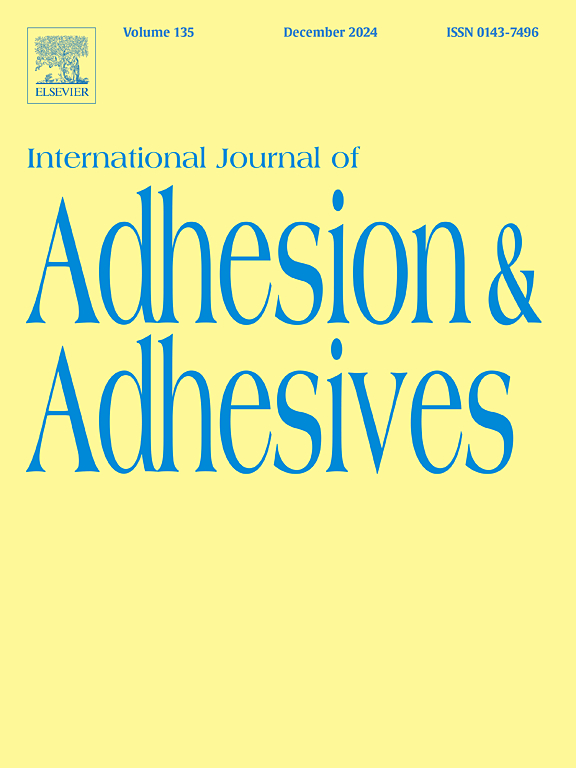Mechanism of improving the shear strength of EVA hot melt adhesives by fumed silica and microsilica powder
IF 3.5
3区 材料科学
Q2 ENGINEERING, CHEMICAL
International Journal of Adhesion and Adhesives
Pub Date : 2025-04-13
DOI:10.1016/j.ijadhadh.2025.104030
引用次数: 0
Abstract
Modification of EVA hot melt adhesives by using inorganic powder is a common method to improve the mechanical properties of hot melt adhesives. In this paper, porous fumed silica with large specific surface area and solid non-porous microsilica powder with small specific surface area were added to EVA hot melt adhesives respectively. The magnitude of the enhancement of the shear strength of EVA hot melt adhesives was explored, and the mechanisms that the two kinds of powders enhance the shear strength were investigated by XPS, ATR-IR, 1HNMR, FE-SEM and DSC. The addition of fumed silica increased the shear strength of the composite hot melt adhesives, and reached the maximum value when the powder content was 2 %, which increased by about 14.3 % compared with pure EVA hot melt adhesives. Through XPS, ATR-IR and 1HNMR it was found that the Si-OH on the surface of SiO2 particles reacted with the ester carbonyl group in EVA to produce polymer alcohol, and the strong polar hydroxyl group on the surface of SiO2 was changed to an acyl oxygen group. The acylation of the particles surface is conducive to reducing the agglomeration of SiO2 particles and improving the compatibility between inorganic particles and organic polymers. The composite hot melt adhesive with 1 %, 2 %, and 3 % fumed silica content shows slight agglomeration of inorganic powder, while the agglomeration is significantly severe when the content is 4 %. DSC analysis showed that the crystallinity of EVA composite hot melt adhesives decreased first and then increased with the increase of powder content, and the decrease of crystallinity increased the shear strength. The improvement of the shear strength can be attributed to the enhancement of the compatibility caused by the reaction between fumed silica and EVA organic, as well as the decrease in crystallinity. The addition of microsilica powder improved the shear strength of the composite hot melt adhesives also, and the maximum value was reached when the powder content is 25 %, which was about 10.6 % higher than that of pure EVA hot melt adhesives. The increase amplitude is smaller than that of fumed silica. The reaction between microsilica powder particles and EVA pure hot melt adhesives was not found by XPS and ATR-IR detection, however, the 1HNMR spectrum showed that there is a partial reaction between them, the degree of reaction was less than that between fumed silica and EVA hot melt adhesive. The crystallinity also showed a trend of first decreasing and then increasing with the increase of powder addition, with the minimum crystallinity at 10 %. The enhancement of the shear strength of hot melt adhesives by microsilica powder may be mainly attributed to the decrease in crystallinity.

气相二氧化硅和微二氧化硅粉提高EVA热熔胶抗剪强度的机理
利用无机粉末对EVA热熔胶进行改性是改善热熔胶力学性能的常用方法。本文将具有大比表面积的多孔气相二氧化硅和具有小比表面积的固体无孔微二氧化硅粉分别添加到EVA热熔胶中。通过XPS、ATR-IR、1HNMR、FE-SEM和DSC分析了两种粉末增强EVA热熔胶抗剪强度的机理。气相二氧化硅的加入提高了复合热熔胶的抗剪强度,当粉含量为2%时达到最大值,比纯EVA热熔胶提高了约14.3%。通过XPS、ATR-IR和1HNMR发现,SiO2颗粒表面的Si-OH与EVA中的酯羰基反应生成聚合物醇,SiO2表面的强极性羟基变为酰基氧。颗粒表面的酰化有利于减少SiO2颗粒的团聚,提高无机颗粒与有机聚合物的相容性。当气相二氧化硅含量为1%、2%和3%时,复合热熔胶的无机粉末结块现象较轻,当气相二氧化硅含量为4%时结块现象较严重。DSC分析表明,随着粉末含量的增加,EVA复合热熔胶的结晶度先降低后升高,结晶度的降低增加了抗剪强度。抗剪强度的提高可归因于气相二氧化硅与EVA有机材料的反应增强了相容性,同时降低了结晶度。微硅粉的加入也提高了复合热熔胶的抗剪强度,当微硅粉含量为25%时达到最大值,比纯EVA热熔胶的抗剪强度提高约10.6%。其增幅小于气相氧化硅的增幅。XPS和ATR-IR检测均未发现微二氧化硅粉颗粒与EVA纯热熔胶之间存在反应,但1HNMR谱显示两者之间存在部分反应,反应程度小于气相二氧化硅与EVA热熔胶之间的反应程度。结晶度也随粉末添加量的增加呈现先降低后升高的趋势,最低结晶度为10%。微硅粉对热熔胶抗剪强度的提高主要是由于其结晶度的降低。
本文章由计算机程序翻译,如有差异,请以英文原文为准。
求助全文
约1分钟内获得全文
求助全文
来源期刊

International Journal of Adhesion and Adhesives
工程技术-材料科学:综合
CiteScore
6.90
自引率
8.80%
发文量
200
审稿时长
8.3 months
期刊介绍:
The International Journal of Adhesion and Adhesives draws together the many aspects of the science and technology of adhesive materials, from fundamental research and development work to industrial applications. Subject areas covered include: interfacial interactions, surface chemistry, methods of testing, accumulation of test data on physical and mechanical properties, environmental effects, new adhesive materials, sealants, design of bonded joints, and manufacturing technology.
 求助内容:
求助内容: 应助结果提醒方式:
应助结果提醒方式:


